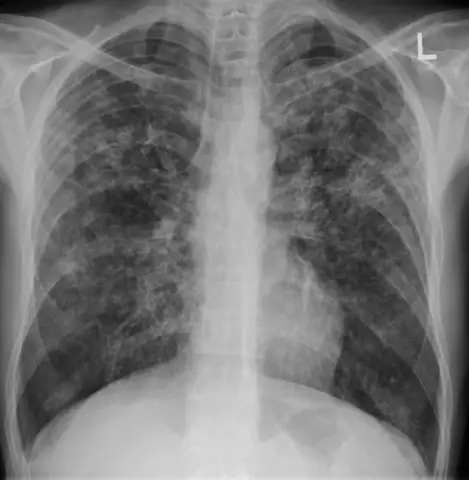- Author Rachel Wainwright [email protected].
- Public 2023-12-15 07:39.
- Last modified 2025-11-02 20:14.
Miliary tuberculosis

Miliary tuberculosis is an acute disease that occurs with the formation of tubercles in several organs. Basically, this tuberculosis is spread by a specific pathogen.
Causes and symptoms of miliary tuberculosis
Miliary tuberculosis can be both acute and chronic. Acute miliary pulmonary tuberculosis is a disease similar to typhus and is severe. Chronic tuberculosis is a wave-like disease with periods of exacerbation and reduction of symptoms.
In adult patients, miliary tuberculosis is a consequence of infection or old blood reactivation. In children, the disease is a consequence of primary tuberculosis.
Miliary pulmonary tuberculosis poses a serious threat to the patient's life when bacteria enter the bloodstream.
With this form of tuberculosis, many injuries to the respiratory and other organs of a person are formed. The main causative agent of the disease is mycobacterium, which is infected by airborne droplets.
A feature of miliary tuberculosis is the spread of the pathogen and the development of foci of inflammation in several organs at once. Against the general background of the disease, the protective functions of the body decrease.
The main symptoms of miliary tuberculosis are weight loss, a sharp rise in temperature, weakness, general malaise, shortness of breath and cough, chills. At severe stages of the course, there is a change in brain stem cells, and leukemia may also appear.
The constant release of bacteria into the bloodstream causes fever and wasting of the body.
Miliary tuberculosis forms foci in the lungs, spleen, intestines, liver, and meninges. Sometimes this disease affects only the lungs, but often it is acute tuberculosis with the genesis of the hematogenous type.
Miliary tuberculosis can be divided into several types:
- typhoid type with fever and intoxication of the body;
- pulmonary type with symptoms of respiratory failure;
- meningeal type with the presence of small foci of spread in the brain.
Diagnosis of the disease

Miliary tuberculosis can be diagnosed on radiographs and tomograms. An X-ray of the chest shows multiple foci of inflammation and lesions in the lungs, as well as foci in other organs.
Sputum and blood tests can determine the presence of mycobacteria. Often patients have a negative Mantoux test.
To establish an accurate diagnosis, ophthalmoscopy, cerebrospinal fluid analysis, biopsy of the lungs and other organs, and bone marrow puncture are prescribed.
Treatment of miliary tuberculosis
The main course of treatment for miliary tuberculosis lasts from 10 to 12 months. Drug therapy includes 3-5 antibacterial drugs, as well as immunostimulating drugs, physiotherapy and breathing exercises.
At a severe stage of the course of the disease, in accordance with the patient's diagnostic indications, the lungs are resected.
As an additional therapy, a clear regime of work and rest, a balanced diet, vitamin therapy, phototherapy and climatotherapy are prescribed.
Often vitamin D, regular intake of dairy products, and calcium supplements are prescribed to strengthen the body in miliary tuberculosis.
If vitamin therapy does not give the required therapeutic effect, then treatment of miliary tuberculosis with streptomycin is prescribed. Also, if necessary, remove luposal foci of the disease in miliary tuberculosis of the cutaneous type.
YouTube video related to the article:
The information is generalized and provided for informational purposes only. At the first sign of illness, see your doctor. Self-medication is hazardous to health!






